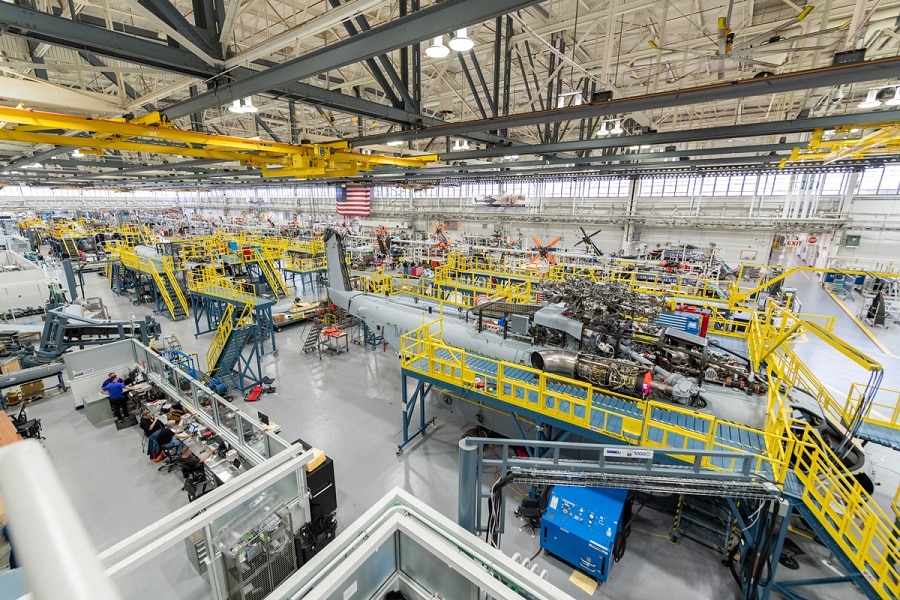Aviation
U.S. Navy Approves Full-Rate Production For Sikorsky CH-53K Helicopter

The U.S. Navy declared full rate production of the Sikorsky CH-53K® helicopter, a decision that is expected to increase production to more than 20 helicopters annually in the coming years. Sikorsky, a Lockheed Martin company (NYSE: LMT), is procuring long-lead items and critical materials to support building full rate production CH-53K helicopters in its digital factory.
U.S. Marine Corps F-35B Nose Gear Collapse Incident At Kadena Air Base(Opens in a new browser tab)
“Ramping up production of the most technologically advanced helicopter in the world allows the U.S. Marine Corps to build out its CH-53K King Stallion fleet and support mission success,” said Bill Falk, director of the Sikorsky CH-53K program. “This production authorization stabilizes Sikorsky’s domestic supply chain and is a testament to our enduring partnership with the Marine Corps.”
This full-rate production decision instills confidence in the diverse network of more than 200 CH‑53K suppliers across 34 states. The Marine Corps’ commitment to the CH-53K will allow suppliers to purchase in bulk, creating efficiencies and driving down overall costs for the U.S. military and international allies.
The Marine Corps’ approved acquisition objective is 200 aircraft. The U.S. Marine Corps declared Initial Operational Capability (IOC) for the CH-53K helicopter in April 2022, validating the platform’s operational readiness to forward deploy Marines and equipment across the globe.
US approves sale of an F16 fighter jet to Pakistan(Opens in a new browser tab)
The CH‑53K is a multi-mission helicopter with heavy-lift capabilities that exceed all other U.S. Department of Defense rotary wing aircraft and is the only heavy-lift helicopter that will remain in production through 2032 and beyond. The CH-53K can carry a 27,000-pound external load over 110 nautical miles in high/hot conditions, which is more than triple the external load carrying capacity of the legacy CH-53E aircraft.
The CH-53K King Stallion is designed to conduct expeditionary assault transport of armored vehicles, equipment, and personnel to support distributed operations deep inland from a sea-based center of operations, critical in the Indo-Pacific region. The CH-53K is a digitally designed, market available aircraft, enabling a range of operations such as humanitarian relief, firefighting and search and rescue.

Aviation
Boeing, Antonov to Collaborate on Defense Projects

– MOU represents Boeing’s commitment to work with Ukrainian industry
– Includes exploring opportunities for collaborating on in-country support of Unmanned Aerial Systems
A Memorandum of Understanding was signed today by Boeing and Antonov Company to investigate potential collaboration on defense-related projects.
“We’re happy to keep collaborating with the Antonov Company to help Ukraine’s economic development and expansion,” stated Ted Colbert, CEO and president of Boeing Defence, Space, & Security.
Airbus and the Antonov An-225: The Best Partnership:Click here
“This agreement demonstrates our ongoing efforts to find more opportunities to work with Ukrainian industry, which was underscored by our signing of the Ukrainian Defence Industry Compact earlier this year.”
The areas of potential collaboration identified in the agreement consist of training, logistical support and overhaul services for tactical Unmanned Aerial Systems utilized by the Ukrainian Armed Forces, which includes the ScanEagle. In addition, the companies will also explore opportunities for Antonov to provide engineering support to Boeing.
The six largest cargo aircraft ever built in the aviation industry:Click here
“A strong, innovative, and efficient defense industry is key to sustainable economic development and national security, and we are extremely excited to collaborate with Boeing,” said Ievhen Gavrylov, CEO of Antonov Company.
This agreement brings a whole new level of opportunity to implement the latest and most effective solutions – in addition to the possibility of future projects with Boeing in the aerospace and defense industry.”
-

 Travel1 week ago
Travel1 week agoAir India to Expand US Operations with Three New Routes After a Decade
-

 Travel2 weeks ago
Travel2 weeks agoWhy We Should Avoid These Stamps in a Passport
-

 Airlines1 month ago
Airlines1 month agoInvestigations Reveal Fake Chinese Titanium in Boeing and Airbus Jets
-

 Tech4 weeks ago
Tech4 weeks agoChina’s CATL Plans 1,800-Mile Electric Plane Launch by 2027
-

 Airport3 days ago
Airport3 days agoTop 10 Largest Airports in the World by Size
-

 Aerospace4 weeks ago
Aerospace4 weeks agoChina’s Fighter Jets Turn Wings into Autonomous Drones
-

 Airlines4 days ago
Airlines4 days agoAir India Rolls Out A350s for Delhi-New York JFK and Newark Routes
-

 Defence3 weeks ago
Defence3 weeks agoBoeing Enhances Chinook with New Engines and Block II Upgrades at $96 Million







